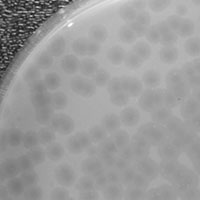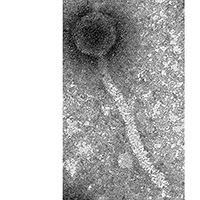Mycobacterium phage BustinJunch
Know something about this phage that we don't? Modify its data.
| Detailed Information for Phage BustinJunch | |
| Discovery Information | |
| Isolation Host | Mycobacterium smegmatis mc²155 |
| Found By | Justin Bunch |
| Year Found | 2013 |
| Location Found | Elizabethtown, KY USA |
| Finding Institution | Western Kentucky University |
| Program | Science Education Alliance-Phage Hunters Advancing Genomics and Evolutionary Science |
| From enriched soil sample? | Yes |
| Isolation Temperature | Not entered |
| GPS Coordinates | 37.731111 N, 85.866667 W Map |
| Discovery Notes | This phage was discovered from a soil sample I collected in Elizabethtown, Kentucky. I collected this sample at the Freeman Lake nature park between a dead tree and a creek with still water. The sample site was well isolated from human activity, was covered by dead leaves, and the soil was saturated by water. The soil sample was then enriched instead of directly plated, and finally I followed the SEA PHAGES lab manual to isolate my bacteriophage and create a stock of the phage, which I used to isolate and purify the DNA of my bacteriophage. |
| Naming Notes | I named the bacteriophage after myself, however, I switched the first letters of my first and last name. I chose this mainly because I am uncreative and I thought the name sounded interesting. |
| Sequencing Information | |
| Sequencing Complete? | No |
| Genome length (bp) | Unknown |
| Character of genome ends | Unknown |
| Fasta file available? | No |
| Characterization | |
| Cluster | Unclustered |
| Subcluster | -- |
| Lysogeny Notes | Based upon the plaques formed by BustinJunch, it can be inferred that the bacteriophage that is BustinJunch is lytic in respect to whether the phage is lytic or lysogenic. One can infer this because the plaques formed are more clear than turbid, which means that the host bacterial cells were completely lysed instead of only having the DNA of the phage being incorporated into the bacterial cell's DNA. |
| Annotating Institution | Unknown or unassigned |
| Annotation Status | Not sequenced |
| Plaque Notes | The plaques formed by BustinJunch are organic-circle in shape, have an average diameter of four (4) millimeters (mm), and are haloed in appearance. This means that the plaque is clear at the center of the plaque, however, the plaque becomes cloudier towards the edges of the plaque. It generally takes BustinJunch twenty-four (24) hours at 37 degrees Celsius to form a full plaque. |
| Has been Phamerated? | No |
| Publication Info | |
| Uploaded to GenBank? | No |
| GenBank Accession | None yet |
| Refseq Number | None yet |
| Archiving Info | |
| Archiving status | Archived |
| SEA Designator | 2013WEKUBustinJunchJMB |
| SEA Lysate Titer | 13,800,000,000 pfu/mL |
| Date of SEA Lysate Titering | Oct 15, 2013 |
| Pitt Freezer Box# | 5 |
| Pitt Freezer Box Grid# | E3 |
| Available Files | |
| Plaque Picture | Download |
| Restriction Digest Picture | Download |
| EM Picture | Download |

